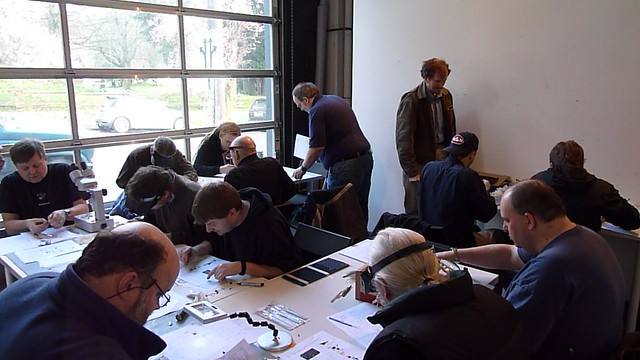I love google+ it often exposes me to really amazing people and projects. Even better, sometimes when you comment, people are very generous with their help. I recently saw a post on Dangerous Prototypes blog about a group build of one of their the Bus Pirate V4. They laid out the parts and did two shifts to build 30 copies of the board.

It was done at Dorkbot PDX (People Doing Strange Things with Electricity in Portland Oregon), and I noticed that they were using a really cool PID controlled hotplate for surfacemount soldering, using a hacked Harbor Freight IR thermometer, and an optimized for the task Arduino clone.
I commented (Google +) on one of the pictures taken by Scott Dixon, one of the organizers, and developers of the soldering system with some questions. The conversation that ensued was very informative and I wanted to share it with you:
Kevin: I’m newish to SMD, but I’m finding in some ways it’s easier than through hole. No more trying to get things flat, etc.
Scott: Definitely. Also no turning the board over all the time to solder the leads, etc…
Kevin: Someone showed me how to use a toaster oven, but a lot of folks I know use the hotplate. Is one better than another?
Scott: For boards with parts primarily on one side, the hot plate is simpler and works fine. I haven’t used a toaster oven but I hear some models work quite well particularly when you want to reflow both sides at once. That was one of the reasons I put the thermocouple interface on the board but so far we haven’t used it for that. Also, some day I might try sous vide.
Kevin: I recently built my first all SMD board. I did it by hand, with a little guidance from an experienced technician. Is there a time when it’s better to use one technique or the other?
There is an interesting cross over point between hand soldering and hot plate reflow depending on the complexity of the board (and how good you are at hand soldering). As an experiment, three of us hand soldered the Bus Pirate. We all have pretty good equipment, including stereo microscopes and we are all pretty good at hand soldering (although nowhere in the league of a tech who does it all the time). It took each of us about 2 hours to do the BPV4 by hand. By comparison, the first time we did the BP on the hotplate it took about 45-50 minutes or so (including getting the parts off the reels, etc). We had a solder paste stencil so that made it somewhat faster. So for something with that many parts it was over twice as long to hand solder. A simpler project would be closer and a really simple project would be faster by hand, compared to setting up the hotplate and cleaning the stencil, etc. If you don’t have a stencil and have to put the solder paste on by hand, that is somewhat slower.
I guess the only other thing I’d add is that we have done a number of SMD workshops and training sessions and our success rate for people walking out with a working project is often 100% and never very much below that. So I would encourage people to give it a try. It is almost certainly easier than you think. It helps if you can find a workshop or class the first time but you can certainly learn on your own.
It doesn’t take that much specialized equipment: Some moderate magnification (3X or so, like reading glasses or a hands free magnifying glass) and a good pair of fine point anti-magnetic tweezers. Maybe a 10X or so magnifier for inspection. If you don’t want to spring for a temperature controlled hot plate or toaster oven, you can certainly make do by manually controlling the heat. Having a temperature control system does reduce the stress though and decrease the likelihood that you will overcook some parts.
And, at least at first, I’d recommend using professionally produced PC boards with solder mask. That helps to control the solder and minimizes solder bridges. DorkbotPDX is a great place to get high quality inexpensive PC boards made!
Oh, and one more thing: If you are putting solder paste on by hand (without a stencil) you will almost certainly err on the side of depositing way too much paste. Think about the fact that a stencil only leaves a solder paste layer a few mils thick and how little paste that actually is.
